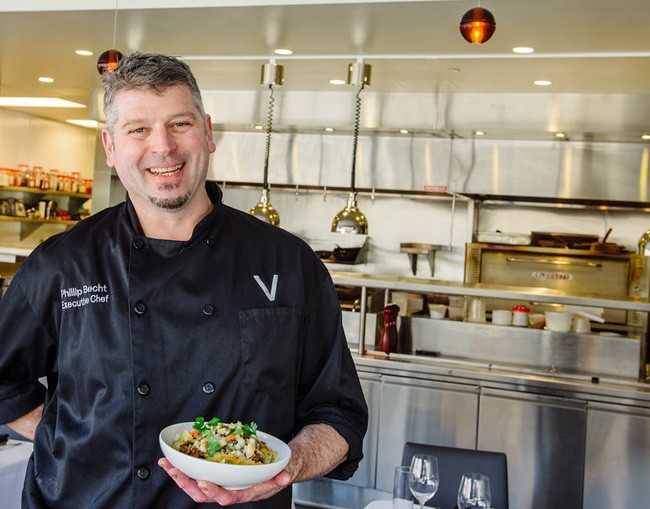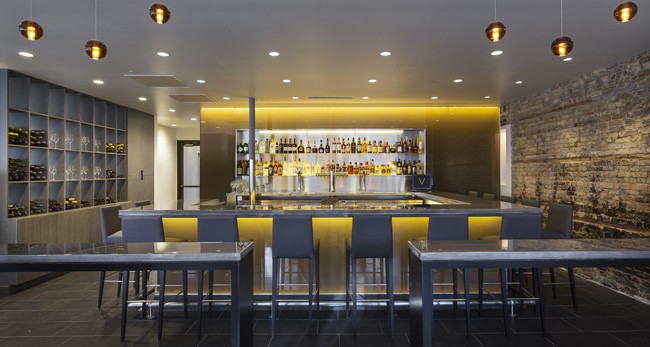
This story is sponsored by Boelter Landmark Restaurant Equipment and Design.
Fine dining is becoming decentralized. Once upon a time, if you wanted serious chef-driven cuisine, seasonal ingredients, and thoughtful decor, there was one place to go, and that was downtown in whatever big city you happened to be closest to.
Now talented chefs and ambitious concepts are springing up in the neighborhoods and suburbs — and restaurants like Victor’s on Water in Excelsior are opening to choruses of interest from locals and traveling adventurers alike.

A Home For Serious Food
The kitchen is the heart of any serious restaurant, and the chef is the heart of that kitchen. Victor’s on Water boasts a spacious open kitchen that is the restaurant’s central artery, a combination of production factory, artist’s studio, and performance stage. For Chef Phillip Becht, it’s the capstone to a culinary career that has been filled with highlights including time spent at the foodie paradise that is the Modern in Northeast Minneapolis and the seasonal-local powerhouse that is Birchwood Cafe.
Becht got his start at the Loring Cafe in Minneapolis (“That infamous restaurant on the park,” he says.) “I was there for many years, 15 years or so. That’s where I met Steven Brown [of Tilia], Lenny Russo [of Heartland], Doug Flicker [of Picolo] – there were a lot of good cooks there at that time. It was a really good place to develop, and there was a lot of freedom.”

Becht brought his years of experience to Victor’s father-daughter co-owner team of Eric Paulson and Janel Novachis, and things began to click as they planned out the restaurant to come.
“They wanted Italian food, so I guess the first thing was to do some research,” says Becht. Books like Paul Bertolli’s Cooking By Hand helped inform his vision, as did menus at restaurants like Roberta’s in Brooklyn, famed for its wood-fired pizzas.
“They knew that they wanted pizzas, they knew they wanted pasta,” says Becht of Victor’s owners, “but they gave me a blank canvas to do the painting. They liked Tuscan food, and that’s where we started. I lobbied — I think in America, we have such a melting pot of ingredients and such an abundance of ingredients to use — I kind of lobbied for: ‘Can we make it: ‘Italy?'”

That broadened definition — a move from “Tuscan food” to a broader vision – opened the gates to flavors from disparate parts of Italy such as Sicily, a gateway for Middle Eastern influences.
“Our vision was Italian, and he convinced us to say Italian-inspired, because of what’s available in our area,” says Novachis, referring to Victor’s use of local and seasonal produce. “We do a thorough change every time the seasons change — the next change will be in mid-April.”

Functional Beauty That’s More Than Skin Deep
Architect Matthew Kreilich of Snow Kreilich worked to transform Victor’s on Water into a modern restaurant, working with real estate that has some notable roots; the site was once Bacon’s Drugstore, a pharmacy that many think played a key role in the creation of the Rolling Stones hit “You Can’t Always Get What You Want.” (Victor’s takes its name from pharmacy owner Victor Bacon.)
It’s important that a restaurant look welcoming and professional to guests — but it’s just as important that it feel welcoming to its staff. In large part, that means a kitchen that works. “[Boelter Landmark] were integral to the kitchen design,” says Novachis. “Phillip, has worked in kitchens forever, so he really worked hand-in-hand with them to design the pieces we needed. We built it with our vision of it being open, and Phillip’s vision of the menu, and Kurt [Grutzmacher] from Landmark put the design together.”
“The bones were here,” says Becht. “But the equipment, yeah, Kurt penciled it in, and I kind of went through it — there were a lot of changes. It’s a very very deep kitchen. There are usually very tight spaces [in restaurant kitchens], so one of the things I noticed right away is how deep this is.”
A deep kitchen means that Victor’s can staff up to handle busy nights and special events. “I can fix problems with people,” says Becht. “I’ve been in so many tight spaces, where if you add more people, you’re less efficient, so I was really struck by the depth of this.”
“We have a back line, too. Kurt was able to find this [equipment] at a good price, so it gives us a lot of options.”

A Bolognese You Can Stand By
Every successful restaurant develops a dish that feels like home. It’s still early for Victor’s, but Becht’s pappardelle hand cut Bolognese is the first dish to survive the nearly complete seasonal overhaul of the restaurant’s menu.
“Eric very early on said ‘I’d like a ragu or bolognese that we can stand by,” says Becht. “We started buying ground meat and making this Bolognese like anybody would, but it occurred to me — and I found some other restaurants that do this — that we could do it by hand.”
What was once a simple process of using ground beef is transformed by Becht and his team into something more painstaking and time consuming: taking a knife to whole cuts of pork, chuck, and veal and slicing them by hand.
“It changes the texture of the dish and the way it comes out, and the whole nature of it,” says Becht. “I’m happy with that.”

Design That Connects
The process of creating a restaurant can be stressful — the constant balancing of budgets and visions, and the process of fleshing out what a night’s service will feel like can be an intense experience. But there’s a plus side, too: designing a space that people feel welcome in.
“It was fun having what’s in your mind and watching it come to fruition,” says Novachis. “It was really exciting. I’m thrilled with the outcome, and I think it looks great. It seems really functional — it was a good process.”

Part of that process, she says, was figuring out the right fit between culinary dreams and kitchen hardware, something Boelter Landmark specializes in. “We wanted to make really good pizzas, but we didn’t want a wood-burning stove,” says Novachis. “[Instead,] we did the deck oven, and it was a great decision, because our pizzas are kind of all the rage. People love them.”
The process of creating Victor has brought together architects and designers, chefs and owners, and that sometimes confounding alchemy of vision and concrete, glass, steel, and wood. In the end, Novachis says, the finished restaurant and Excelsior seem made for one another. “I was concerned that this area wasn’t ready for our vision of food and I have been incredibly surprised by everyone’s response,” she says. “People love it, and we hear multiple times, every night: ‘This is what we needed out here.’ The response has been above and beyond anything I could have anticipated.”
Victor’s on Water, 205 Water Street Excelsior, MN, 952.474.8879 | Boelter Landmark Restaurant Equipment and Design

